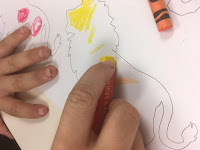Socially Engaged Art was the theme for the Summer Institute
of Contemporary Art or SICA 2017. I attended SICA 2015 and I enjoyed it so much
that I couldn't wait to return to Penn State to enjoy it again this year. It
did not disappoint. Before I get into all the wonderful knowledge that I gained
I want to say just how friendly and accommodating everyone was. I was given
rides to and from my hotel by people attending the institute and by a dear
woman who I met last time I was there. There's a special camaraderie among art
teachers that just can't be beat. I am glowing and feeling super
intelligent at the moment!
I gotta say I really didn't understand what I was getting
myself into with the theme Socially Engaged Art. I thought is was about getting
more social through your art, okay really clueless here. But I remembered how
nice everyone was and how they fed us breakfast and lunch and paid for my hotel
room and the institute was FREE. AND I really like learning NEW things.
So it turns out that one example of Socially Engaged Art is the melding of
art and social work. In other words as an artist working in a community, one
needs to be aware of what can help that community to thrive. An example of that
would be the water filters we made on the second day of SICA.
I was stunned to learn that there are many people in the
United States that do not have access to clean water. With that in mind using
just clay, sawdust and water we learned how to make ceramic water filters.
First we sifted wood shavings (from the campus woodworking shop) through screens to separate
the sawdust from the larger pieces.
Then we measured out equal amounts of sawdust and clay onto
a large tarp and mixed it together. This was done by sifting the contents
within the tarp back and forth a few
times.
Then that mixture was gently poured into a wheel barrel along with some
water scooped up from the ground. (It rained earlier.)
After that was all mixed together we used a plaster mold in
which to make the water filter. (The mold was made using half a football nerf
ball. As that was a perfect shape for the filter.)
We started out making a small pinch pot with our clay
mixture and pressed it into the bottom of the plaster mold, then continued by
adding coils until the inside of the mold, through to the lip of the mold, was
covered in the clay mixture.
When the clay is hard and dry it will be fired in a GAS kiln
as the sawdust will burn out and not be kind to an electric kiln.
The finished water filter can then be placed on the lip of a
bucket with a spout. Dirty water goes in the top and clean water comes out the
bottom into the bucket. This process will clean the water by 95%.
So there you have it-artists socially engaged making art to
help people. Okay, now that was just ONE example another example might be to
make people aware of something you might not agree with. Sort of getting the
word out, being an activist on a cause that’s important to you. But that my friends that is a whole another story!!
I want to give a shout out to both Dana Carlisle Kletchka and B. Stephen Carpenter II for ALL their hard work. Without them, I'm not sure there would be a Summer Institute.........
Thanks for reading!
I would love to hear about any fun summer professional development you have planned for the summer!




































